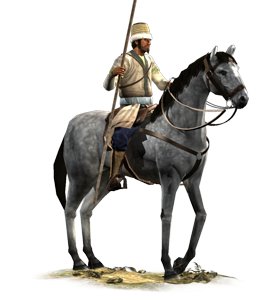Difference between revisions of "Native Lancers (ETW Unit)"
(Created page with "These cavalrymen are armed with a long spear or lance that makes them particularly deadly when charging. {{Unit|image=Image:Native_Lancers.jpg|Class=Lancers Cavalry |Men= ...") |
|||
| Line 6: | Line 6: | ||
|Recruitable From= | |Recruitable From= | ||
Military Academy | Military Academy | ||
| + | |||
Army Board | Army Board | ||
| + | |||
Army Staff College | Army Staff College | ||
| − | Prestige France Palais Bourbon | + | |
| + | Prestige France Palais Bourbon | ||
| + | |||
Prestige Maratha Shaniwarwada | Prestige Maratha Shaniwarwada | ||
| + | |||
Prestige Poland Akademia | Prestige Poland Akademia | ||
| + | |||
Prestige Prussia Brandenburg Gate | Prestige Prussia Brandenburg Gate | ||
|Region= Global | |Region= Global | ||
Revision as of 14:08, 13 December 2010
These cavalrymen are armed with a long spear or lance that makes them particularly deadly when charging.
Overview
The lance is probably the oldest cavalry weapon. It gives the user a chance to put all the momentum of himself and his charging horse into one very sharp point that can, in the hands of a skilled man, be driven right through any man. This is what makes lances so intimidating to face but, if the lancer does not kill his target, he is then vulnerable. A long lance is a good deal less use in a melee than a sword, and a lancer is at a disadvantage once the close fighting starts.
Historically, many nations used lancers, although the European fashion for them owes much to the uhlans: cavalry raised for Austrian and Prussian service. The French adopted lancers with some enthusiasm, and Napoleon even included Polish lancers in his Imperial Guard. In India the lance had long been used as a weapon, and lancer skills were often improved by "pegging" (picking tent pegs out of the ground with the lance tip) or pig-sticking (hunting wild pigs or even wild dogs with the lance). Native Indian lancers were rightly feared by European troops.
